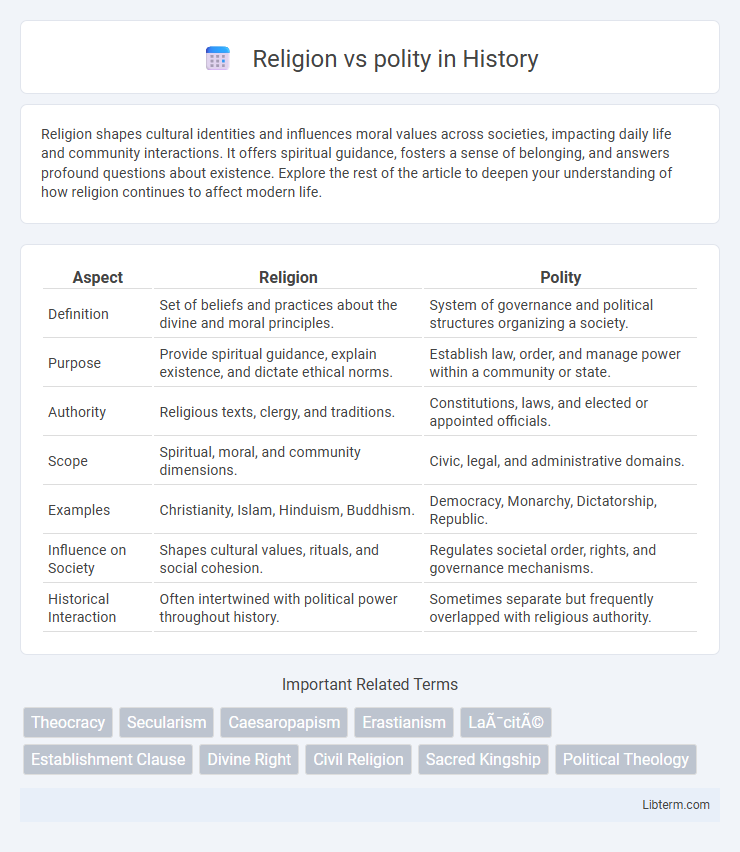Religion shapes cultural identities and influences moral values across societies, impacting daily life and community interactions. It offers spiritual guidance, fosters a sense of belonging, and answers profound questions about existence. Explore the rest of the article to deepen your understanding of how religion continues to affect modern life.
Table of Comparison
| Aspect | Religion | Polity |
|---|---|---|
| Definition | Set of beliefs and practices about the divine and moral principles. | System of governance and political structures organizing a society. |
| Purpose | Provide spiritual guidance, explain existence, and dictate ethical norms. | Establish law, order, and manage power within a community or state. |
| Authority | Religious texts, clergy, and traditions. | Constitutions, laws, and elected or appointed officials. |
| Scope | Spiritual, moral, and community dimensions. | Civic, legal, and administrative domains. |
| Examples | Christianity, Islam, Hinduism, Buddhism. | Democracy, Monarchy, Dictatorship, Republic. |
| Influence on Society | Shapes cultural values, rituals, and social cohesion. | Regulates societal order, rights, and governance mechanisms. |
| Historical Interaction | Often intertwined with political power throughout history. | Sometimes separate but frequently overlapped with religious authority. |
Defining Religion and Polity
Religion encompasses organized systems of beliefs, rituals, and moral codes centered on the divine or sacred, often guiding individual and communal ethics. Polity refers to structured political organizations or systems of governance that regulate societal order through laws, institutions, and authority mechanisms. While religion shapes cultural values and social norms, polity establishes formalized frameworks for political power and decision-making.
Historical Interplay of Faith and Governance
The historical interplay of faith and governance reveals how religion has shaped political institutions and laws across civilizations, from the divine right of kings in medieval Europe to the theocratic systems in ancient Mesopotamia. Religious doctrines often influenced the legitimacy of rulers and the moral frameworks underpinning legal codes, while political powers periodically co-opted religious authority to consolidate control. This dynamic tension between sacred beliefs and statecraft continues to inform contemporary debates on church-state relations and secular governance models.
Secularism: Bridging or Dividing Religion and State
Secularism acts as a framework that delineates the boundaries between religion and state, promoting neutrality to prevent religious dominance in political affairs. It fosters inclusivity by ensuring equal treatment of all religious groups, thereby reducing potential conflicts in pluralistic societies. However, the implementation of secularism can also spark debates over religious freedom and identity, influencing the dynamic interplay between faith and governance.
Theocratic States: Governance by Divine Law
Theocratic states govern through divine law, where religious authority and political power are unified, creating a system in which clergy or religious leaders hold supreme control over legislation and enforcement. Examples include Iran and Vatican City, where religious doctrines directly shape legal frameworks, social policies, and national governance. This fusion of religion and polity often results in laws that prioritize spiritual mandates over secular considerations, influencing civil rights and state administration.
Religious Freedom and Legal Frameworks
Religious freedom is a fundamental human right protected by international legal frameworks such as the Universal Declaration of Human Rights and various national constitutions, ensuring individuals can practice their faith without state interference. Legal frameworks balance religious liberties with public order by regulating practices that may conflict with secular laws while preventing discrimination or persecution based on religion. The dynamic interaction between religion and polity often shapes legislation, influencing policies on education, dress codes, and religious expression in public spaces.
Political Influence of Religious Institutions
Religious institutions have historically shaped political landscapes by influencing legislation, policy formation, and voter behavior, often leveraging moral authority to sway public opinion. In countries like Iran and the Vatican, religious leadership directly governs political power, while in secular democracies, faith-based groups lobby to affect social and ethical laws. The intertwining of religion and politics impacts governance stability, minority rights, and the separation of church and state principles worldwide.
Case Studies: Religion’s Role in Modern Politics
Religion profoundly shapes modern politics by influencing policy-making, voter behavior, and national identity, as seen in the United States where Evangelical Christianity impacts conservative legislation. In India, Hindu nationalism drives political agendas, affecting secularism and minority rights. These case studies reveal religion's complex role in legitimizing political authority and mobilizing support.
Policy-Making in Multifaith Societies
Policy-making in multifaith societies requires balancing religious diversity with secular governance to ensure equal rights and social cohesion. Effective policies promote interfaith dialogue, protect religious freedoms, and prevent discrimination while maintaining state neutrality in religious matters. Governments must navigate complex religious landscapes to create inclusive frameworks that respect cultural plurality and uphold democratic principles.
Conflicts and Alliances: Religion vs. State Interests
Conflicts between religion and state interests often arise when religious doctrines challenge secular laws, leading to disputes over legislation on issues like education, reproductive rights, and freedom of expression. Political alliances with religious institutions can strengthen governance but risk marginalizing minority beliefs and undermining secularism. Historical and contemporary examples reveal that balancing religious influence with state authority is crucial to maintaining social cohesion and political stability.
Future Trends: Harmonizing Religion and Polity
Future trends in harmonizing religion and polity emphasize integrated policy frameworks that respect religious diversity while ensuring secular governance. The rise of interfaith dialogues coupled with digital platforms facilitates greater religious inclusivity in political decision-making. Emerging global governance models prioritize balancing religious freedoms with human rights, promoting social cohesion and political stability.
Religion Infographic

 libterm.com
libterm.com